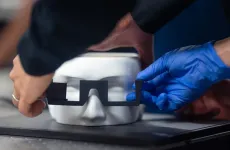(Press-News.org) Researchers in the emerging field of spatial computing have developed a prototype augmented reality headset that uses holographic imaging to overlay full-color, 3D moving images on the lenses of what would appear to be an ordinary pair of glasses. Unlike the bulky headsets of present-day augmented reality systems, the new approach delivers a visually satisfying 3D viewing experience in a compact, comfortable, and attractive form factor suitable for all-day wear.
“Our headset appears to the outside world just like an everyday pair of glasses, but what the wearer sees through the lenses is an enriched world overlaid with vibrant, full-color 3D computed imagery,” said Gordon Wetzstein, an associate professor of electrical engineering and an expert in the fast-emerging field of spatial computing. Wetzstein and a team of engineers introduce their device in a new paper in the journal Nature.
Though only a prototype now, such a technology, they say, could transform fields stretching from gaming and entertainment to training and education – anywhere computed imagery might enhance or inform the wearer’s understanding of the world around them.
“One could imagine a surgeon wearing such glasses to plan a delicate or complex surgery or airplane mechanic using them to learn to work on the latest jet engine,” Manu Gopakumar, a doctoral student in the Wetzstein-led Stanford Computational Imaging lab and co-first author of the paper said.
Barriers overcome
The new approach is the first to thread a complex maze of engineering requirements that have so far produced either ungainly headsets or less-than-satisfying 3D visual experiences that can leave the wearer visually fatigued, or even a bit nauseous at times.
“There is no other augmented reality system out there now with comparable compact form factor or that matches our 3D image quality,” said Gun-Yeal Lee, a postdoctoral researcher in the Stanford Computational Imaging lab and co-first author of the paper.
To succeed, the researchers have overcome technical barriers through a combination of AI-enhanced holographic imaging and new nanophotonic device approaches. The first hurdle was that the techniques for displaying augmented reality imagery often require the use of complex optical systems. In these systems, the user does not actually see the real world through the lenses of the headset. Instead, cameras mounted on the exterior of the headset capture the world in real time and combine that imagery with computed imagery. The resulting blended image is then projected to the user’s eye stereoscopically.
“The user sees a digitized approximation of the real world with computed imagery overlaid. It’s sort of augmented virtual reality, not true augmented reality,” explained Lee.
These systems, Wetzstein explains, are necessarily bulky because they use magnifying lenses between the wearer’s eye and the projection screens that require a minimum distance between the eye, the lenses, and the screens, leading to additional size.
“Beyond bulkiness, these limitations can also lead to unsatisfactory perceptual realism and, often, visual discomfort,” said Suyeon Choi, a doctoral student in the Stanford Computational Imaging lab and co-author of the paper.
Killer app
To produce more visually satisfying 3D images, Wetzstein leapfrogged traditional stereoscopic approaches in favor of holography, a Nobel-winning visual technique developed in the late-1940s. Despite great promise in 3D imaging, more widespread adoption of holography has been limited by an inability to portray accurate 3D depth cues, leading to an underwhelming, sometimes nausea-inducing, visual experience.
The Wetzstein team used AI to improve the depth cues in the holographic images. Then, using advances in nanophotonics and waveguide display technologies, the researchers were able to project computed holograms onto the lenses of the glasses without relying on bulky additional optics.
A waveguide is constructed by etching nanometer-scale patterns onto the lens surface. Small holographic displays mounted at each temple project the computed imagery through the etched patterns which bounce the light within the lens before it is delivered directly to the viewer’s eye. Looking through the glasses’ lenses, the user sees both the real world and the full-color, 3D computed images displayed on top.
Life-like quality
The 3D effect is enhanced because it is created both stereoscopically, in the sense that each eye gets to see a slightly different image as they would in traditional 3D imaging, and holographically.
“With holography, you also get the full 3D volume in front of each eye increasing the life-like 3D image quality,” said Brian Chao, a doctoral student in the Stanford Computational Imaging lab and also co-author of the paper.
The ultimate outcome of the new waveguide display techniques and the improvement in holographic imaging is a true-to-life 3D visual experience that is both visually satisfying to the user without the fatigue that has challenged earlier approaches.
“Holographic displays have long been considered the ultimate 3D technique, but it’s never quite achieved that big commercial breakthrough,” Wetzstein said. “Maybe now they have the killer app they’ve been waiting for all these years.”
Additional authors are from The University of Hong Kong and NVIDIA. Wetzstein is also member of Stanford Bio-X, the Wu Tsai Human Performance Alliance, and the Wu Tsai Neurosciences Institute.
This research was funded by a Stanford Graduate Fellowship in Science and Engineering, the National Research Foundation of Korea (NRF) funded by the Ministry of Education, a Kwanjeong Scholarship, a Meta Research PhD Fellowship, the ARO PECASE Award, Samsung, and the Sony Research Award Program. Part of this work was performed at the Stanford Nano Shared Facilities (SNSF) and Stanford Nanofabrication Facility (SNF), supported by the National Science Foundation and the National Nanotechnology Coordinated Infrastructure.
END
AI and holography bring 3D augmented reality to regular glasses
Combining advances in display technologies, holographic imaging, and artificial intelligence, engineers at Stanford say they have produced a leap forward for augmented reality
2024-05-08
ELSE PRESS RELEASES FROM THIS DATE:
Estimated number of children who lost a parent to drug overdose in the US from 2011 to 2021
2024-05-08
About The Study: More than 320,000 children in the U.S. lost a parent to drug overdose between 2011-2021, with significant disparities evident across racial and ethnic groups. Given the potential short- and long-term negative impact of parental loss, program and policy planning should ensure that responses to the overdose crisis account for the full burden of drug overdose on families and children, including addressing the economic, social, educational, and health care needs of children who have lost parents to overdose.
Corresponding Author: To contact the ...
Sexual harassment, abuse, and discrimination in obstetrics and gynecology
2024-05-08
About The Study: The findings of this study suggest that there is a high prevalence of harassment in OB-GYN despite being a predominantly female field for the last decade.
Corresponding Author: To contact the corresponding author, Ankita Gupta, M.D., M.P.H., email ankita.gupta@louisville.edu.
To access the embargoed study: Visit our For The Media website at this link https://media.jamanetwork.com/
(doi:10.1001/jamanetworkopen.2024.10706)
Editor’s Note: Please see the article for additional information, including other authors, author contributions and affiliations, conflict of interest and financial disclosures, ...
Childhood maltreatment responsible for up to 40 percent of mental health conditions
2024-05-08
A study examining childhood maltreatment in Australia has revealed the shocking burden for Australians, estimating it causes up to 40 percent of common, life-long mental health conditions.
The mental health conditions examined were anxiety, depression, harmful alcohol and drug use, self-harm and suicide attempts. Childhood maltreatment is classified as physical, sexual and emotional abuse, and emotional or physical neglect before the age of 18.
Childhood maltreatment was found to account for 41 percent of suicide attempts in Australia, 35 percent for cases of self-harm and 21 percent for depression.
The ...
Strictly no dancing
2024-05-08
Since the discovery of quantum mechanics more than a hundred years ago, it has been known that electrons in molecules can be coupled to the motion of the atoms that make up the molecules. Often referred to as molecular vibrations, the motion of atoms act like tiny springs, undergoing periodic motion. For electrons in these systems, being joined to the hip with these vibrations means they are constantly in motion too, dancing to the tune of the atoms, on timescales of a millionth of a billionth of a second. But all this dancing around leads ...
Rock steady: Study reveals new mechanism to explain how continents stabilized
2024-05-08
UNIVERSITY PARK, Pa. — Ancient, expansive tracts of continental crust called cratons have helped keep Earth’s continents stable for billions of years, even as landmasses shift, mountains rise and oceans form. A new mechanism proposed by Penn State scientists may explain how the cratons formed some 3 billion years ago, an enduring question in the study of Earth’s history.
The scientists reported today (May 8) in the journal Nature that the continents may not have emerged from Earth’s ...
A new, low-cost, high-efficiency photonic integrated circuit
2024-05-08
The rapid advancement in photonic integrated circuits (PICs), whichcombine multiple optical devices and functionalities on a single chip, has revolutionized optical communications and computing systems.
For decades, silicon-based PICs have dominated the field due to their cost-effectiveness and through their integration with existing semiconductor manufacturing technologies, despite their limitations with regard to their electro-optical modulation bandwidth. Nevertheless, silicon-on-insulator optical transceiver chips were successfully commercialized, driving information traffic through millions of glass fibers in modern datacenters.
Recently, the lithium niobate-on-insulator ...
Mount Sinai scientists unravel how psychedelic drugs interact with serotonin receptors to potentially produce therapeutic benefits
2024-05-08
Researchers at the Icahn School of Medicine at Mount Sinai have shed valuable light on the complex mechanisms by which a class of psychedelic drugs binds to and activates serotonin receptors to produce potential therapeutic effects in patients with neuropsychiatric disorders such as depression and anxiety. In a study published May 8 in Nature, the team reported that certain psychedelic drugs interact with an underappreciated member of the serotonin receptor family in the brain known as 5-HT1A to produce therapeutic benefits in animal models.
“Psychedelics like LSD and psilocybin have entered clinical trials with promising early results, though we still don’t ...
Keck Medicine of USC earns ‘LGBTQ+ Healthcare Equality Leader’ 2024 designation
2024-05-08
LOS ANGELES — Keck Medicine of USC hospitals and USC Student Health, part of Keck Medicine, received the ‘LGBTQ+ Healthcare Equality Leader’ designation in the Human Rights Campaign Foundation’s 2024 Healthcare Equality Index (HEI).
HEI is the leading national benchmarking survey of health care facility policies and practices dedicated to the equitable treatment and inclusion of LGBTQ+ patients, visitors and employees. A record 1,065 health care facilities participated in the 2024 HEI survey; ...
New guidelines for depression care emphasize patient-centred approach
2024-05-08
Psychiatrists and mental health professionals have a new standard for managing major depression, thanks to refreshed clinical guidelines published today by the Canadian Network for Mood and Anxiety Treatments (CANMAT).
The CANMAT guidelines are the most widely used clinical guidelines for depression in the world. The new version integrates the latest scientific evidence and advances in depression care since the previous guidelines were published in 2016. The update was led by researchers at the University of B.C. and the University of Toronto, alongside ...
Children sleep problems associated with psychosis in young adults
2024-05-08
Children who experience chronic lack of sleep from infancy may be at increased risk of developing psychosis in early adulthood, new research shows.
Researchers at the University of Birmingham examined information on nighttime sleep duration from a large cohort study of children aged between 6 months and 7 years old. They found that children who persistently slept fewer hours, throughout this time period, were more than twice as likely to develop a psychotic disorder in early adulthood, and nearly four times as likely to have a psychotic episode.
While ...
LAST 30 PRESS RELEASES:
Heart-brain connection: international study reveals the role of the vagus nerve in keeping the heart young
Researchers identify Rb1 as a predictive biomarker for a new therapeutic strategy in some breast cancers
Survey reveals ethical gaps slowing AI adoption in pediatric surgery
Stimulant ADHD medications work differently than thought
AI overestimates how smart people are, according to HSE economists
HSE researchers create genome-wide map of quadruplexes
Scientists boost cell "powerhouses" to burn more calories
Automatic label checking: The missing step in making reliable medical AI
Low daily alcohol intake linked to 50% heightened mouth cancer risk in India
American Meteorological Society announces Rick Spinrad as 2026 President-Elect
Biomass-based carbon capture spotlighted in newly released global climate webinar recording
Illuminating invisible nano pollutants: advanced bioimaging tracks the full journey of emerging nanoscale contaminants in living systems
How does age affect recovery from spinal cord injury?
Novel AI tool offers prognosis for patients with head and neck cancer
Fathers’ microplastic exposure tied to their children’s metabolic problems
Research validates laboratory model for studying high-grade serous ovarian cancer
SIR 2026 delivers transformative breakthroughs in minimally invasive medicine to improve patient care
Stem Cell Reports most downloaded papers of 2025 highlight the breadth and impact of stem cell research
Oxford-led study estimates NHS spends around 3% of its primary and secondary care budget on the health impacts of heat and cold in England
A researcher’s long quest leads to a smart composite breakthrough
Urban wild bees act as “microbial sensors” of city health.
New study finds where you live affects recovery after a hip fracture
Forecasting the impact of fully automated vehicle adoption on US road traffic injuries
Alcohol-related hospitalizations from 2016 to 2022
Semaglutide and hospitalizations in patients with obesity and established cardiovascular disease
Researchers ‘listen in’ to embryo-mother interactions during implantation using a culture system replicating the womb lining
How changing your diet could help save the world
How to make AI truly scalable and reliable for real-time traffic assignment?
Beyond fragmented markets: A new framework for efficient and stable ride-pooling
Can shape priors make road perception more reliable for autonomous driving?
[Press-News.org] AI and holography bring 3D augmented reality to regular glassesCombining advances in display technologies, holographic imaging, and artificial intelligence, engineers at Stanford say they have produced a leap forward for augmented reality





